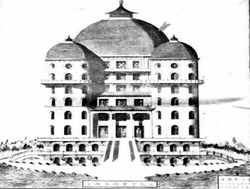Confucian church
| Confucianism |
|---|
 |
|
Schools |
|
Confucianism by country |
|
Confucian texts Four Books: Five Classics: Other: |
| Portal Confucianism |
The Confucian church (Chinese: 孔教会; pinyin: Kǒng jiàohuì or pinyin: Rú jiàohuì) is a Confucian religious and social institution of the congregational type. It was first proposed by Kang Youwei (1858–1927) in the last years of the 19th century, as a state religion of Qing China on the model of Europe.[2]
The "Confucian church" model was later continued amongst overseas Chinese communities,[3] who established independent Confucian churches active on the local level, especially in Indonesia and the United States.
In contemporary China, since 2000, there has been a revival of Confucianism with the proliferation of Confucian academies (Chinese: 书院; pinyin: shūyuàn), the opening and reopening of temples of Confucius, the new phenomenon of grassroots Confucian communities or congregations (Chinese: 社区儒学; pinyin: shèqū rúxué) and renewed talks about a national "Confucian church".[4] A national Holy Confucian Church (Chinese: 孔圣会; pinyin: Kǒngshènghuì) was established with the participation of many Confucian leaders on November 1, 2015; the current spiritual leader is Jiang Qing.
Kang Youwei's national Confucian Church
The idea of a "Confucian Church" as the state religion of China was proposed in detail by Kang Youwei as part of an early New Confucian search for a regeneration of the social relevance of Confucianism, at a time when it was de-institutionalised with the collapse of the Qing dynasty and the Chinese empire.[3] Kang modeled his ideal "Confucian Church" after European national Christian churches, as a hierarchical and centralised institution, closely bound to the state, with local church branches, Sunday prayers and choirs, missions, journals, and even baptism sometimes, devoted to the worship and the spread of the teachings of Confucius.[3][5]
The large community of Confucian literati who were left bereft of a ritual and organisational outlet for their values and identity after the dissolution of state Confucianism, supported such projects.[5] Similar models were also followed by various newly created Confucian folk religious sects, such as the Xixinshe, the Daode Xueshe, and the Wanguo Daodehui.[5]
The Confucian Church was founded by a disciple of Kang, Chen Huanzhang, in 1912, and within a few years it established 132 branches countrywise.[6] From 1913 to 1916, an important debate took place whether Confucianism should become the state religion (guo jiao) and as such inscribed in the constitution of China.[6] This finally didn't occur, and anti-religious campaigns mounting in the 1920s led to a dissolution of the Confucian church.[6]
Modern churches and congregations
While Kang's idea was not realised in China, it was carried forward in Hong Kong and amongst overseas Chinese peoples.[3] The Hong Kong branch of Kang's movement took the name of "Confucian Academy" (Chinese: 孔教学院), while the Indonesian branch became the Supreme Council for the Confucian Religion in Indonesia. Members believe in Tian with Confucius as the prophet (Indonesian nabi).[7] Chinese people in the United States established independent, local Confucian churches such as the Confucius Church of Sacramento or the Confucius Church of Salinas.
In contemporary China, the Confucian revival has developed into different, yet interwoven, directions: the proliferation of Confucian academies,[7] the resurgence of Confucian rites,[7] and the birth of new forms of Confucian activity on the popular level, such as the Confucian communities. Some scholars also consider the reconstruction of Chinese lineage associations and their ancestral shrines, as well as cults and temples of natural and national gods within broader Chinese traditional religion, as part of the revival of Confucianism.[8]
Other forms of revival are folk religious[9] or salvationist religious[10] groups with a Confucian focus or Confucian churches, for example the Yidan xuetang (一耽学堂) based in Beijing,[11] the Mengmutang (孟母堂) of Shanghai,[12] the Way of the Gods according to the Confucian Tradition or Phoenix Churches,[13] the Confucian Fellowship (儒教道坛 Rújiào Dàotán) in northern Fujian which has spread rapidly over the years after its foundation,[13] and ancestral shrines of the Kong family operating as well as Confucian-teaching churches.[12]
Also, the Hong Kong Confucian Academy has expanded its activities to the mainland, with the construction of statues of Confucius, Confucian hospitals, restoration of temples and sponsorship of other activities.[14] In 2009 Zhou Beichen founded another institution that inherits the idea of Kang Youwei's Confucian Church, the Holy Hall of Confucius (孔圣堂 Kǒngshèngtáng) in Shenzhen affiliated with the Federation of Confucian Culture of Qufu,[15] the first of a nationwide movement of congregations and civil organisations that was unified in 2015 by the Holy Confucian Church (孔圣会 Kǒngshènghuì).
Chinese folk religion's temples and kinship ancestral shrines on special occasion may choose Confucian liturgy (that is called 儒 rú, or sometimes 正统 zhèngtǒng, meaning "orthoprax ritual style") led by Confucian ritual masters (礼生 lǐshēng) to worship the gods enshrined, instead of Taoist or popular ritual.[16] "Confucian businessmen" (rushang, also "learned businessman"), is a recently recovered term to identify people of the entrepreneurial or economic elite who recognise their social responsibility and therefore apply Confucian culture to their business.[17]
Contemporary New Confucian scholars Jiang Qing[7] and Kang Xiaoguang are amongst the most influential supporters of institutionalising the Confucian revival as a national "Confucian Church".[18] Jiang Qing is the current spiritual leader of the Holy Confucian Church.
List of churches
- Confucian Fellowship (儒教道坛 Rújiào Dàotán)[13]
- Daode Xueshe (道德学社 "Community for the Study of the Way and its Virtue")[5]
- Holy Confucian Church (孔圣会 Kǒngshènghuì)
- Kongdaoshe (孔道社 "Community of the Way of Confucius")[19]
- Kong Meng Xuehui (孔孟学会 "Society of Confucius and Mencius")[20]
- Kong Meng Shengdao Hui (孔孟圣道会 "Church of the Sacred Way of Confucius and Mencius")[20]
- Mengmutang (孟母堂)
- Ruists' Society (儒社 Rúshè) and Ruist Masters' Society (儒士社 Rúshìshè), two modern networks of Confucians in mainland China
- Ruzong Luandao (儒宗鸾道 "Way of the Phoenix according to the Confucian Tradition"), phoenix churches[21]
- Shengdao (圣道 "Holy Way"), a Xiantiandao branch best known by its corporate name of Tongshanshe (同善社 "Community of the Goodness")[22]
- Shenglishe (圣理社 "Community of the Holy Truth")[23]
- Wanguo Daodehui (万国道德会 "Universal Church of the Way and its Virtue")[5]
- Jiushi teaching (救世教 Jiùshì jiào, "Life Healing"), also known by its corporate name Wushanshe (悟善社 "Community of the Awakening to the Goodness")[5]
- Xin Rujiao Hui (新儒教会 "New Confucian Church")[20]
- Xixinshe (洗心社 "Community of the Pure Heart")[5]
- Xuanyuanism (軒轅教 Xuānyuán jiào)[23]
- Yidan xuetang (一耽学堂)
- Zongsheng Hui (宗圣会 "Church of the Great Sage")[19]
See also
References
- ↑ Tay Wei Leong. SAVING THE CHINESE NATION AND THE WORLD: RELIGION AND CONFUCIAN REFORMATION, 1880s-1937. National University of Singapore, 2012. pp. 96-98
- ↑ Ya-pei Kuo, 2010.
- 1 2 3 4 Yong Chen, 2012. p. 174
- ↑ Billioud, 2010. p. 201
- 1 2 3 4 5 6 7 Goossaert (2011), p. 95.
- 1 2 3 Billioud, 2010. p. 207
- 1 2 3 4 Yong Chen, 2012. p. 175
- ↑ Fan, Chen. 2015. (a). p. 7
- ↑ Billioud, 2010. p. 203
- ↑ Billioud, 2010. p. 214
- ↑ Billioud, 2010. p. 219
- 1 2 Fan, Chen. 2015. p. 29
- 1 2 3 Fan, Chen. 2015. p. 34
- ↑ Billioud (2015), p. 148.
- ↑ Billioud (2015), p. 152-156.
- ↑ Clart, 2003. pp. 3-5
- ↑ Billioud, 2010. p. 204
- ↑ Angle, 2012. § Ritual, Education, and the State.
- 1 2 Tay Wei Leong. SAVING THE CHINESE NATION AND THE WORLD: RELIGION AND CONFUCIAN REFORMATION, 1880s-1937. National University of Singapore, 2012. p. 60
- 1 2 3 Clart, Jones. 2003. p. 71
- ↑ Clart, Jones. 2003. p. 72
- ↑ D. Palmer. Redemptive Societies as Confucian NRMs?. Journal of Chinese Theatre, Ritual and Folklore / Minsu Quyi, 172 (2011): 1-12. Line 172: «Tongshanshe emphasized that it was “primarily Confucian” 以儒家為主».
- 1 2 Clart, Jones. 2003. p. 73
Sources
- Billioud, Sebastien; Joel Thoraval (2015). The Sage and the People: The Confucian Revival in China. Oxford University Press. ISBN 0190258144.
- Goossaert, Vincent; David Palmer (2011). The Religious Question in Modern China. University of Chicago Press. ISBN 022600533X.
- Clart, Philip. Confucius and the Mediums: Is There a "Popular Confucianism"?. On: T'uong Pao LXXXIX. Brill, Leiden, 2003.
- Fan Lizhu, Chen Na. Revival of Confucianism and Reconstruction of Chinese Identity. Paper presented at: The Presence and Future of Humanity in the Cosmos, ICU, Tokyo, 18–23 March 2015. (a)
- Fan Lizhu, Chen Na. The Religiousness of "Confucianism" and the Revival of Confucian Religion in China Today. On: Cultural Diversity in China 1: 27-43. De Gruyter Open, 2015. ISSN 2353-7795, DOI: 10.1515/cdc-2015-0005
- Payette, Alex. Shenzhen's Kongshengtang: Religious Confucianism and Local Moral Governance. Part of: Role of Religion in Political Life, Panel RC43, 23rd World Congress of Political Science, 19–24 July 2014.
- Stephen C. Angle. Contemporary Confucian Political Philosophy. Polity, 2012. ISBN 0745661300
- Sébastien Billioud. Carrying the Confucian Torch to the Masses: The Challenge of Structuring the Confucian Revival in the People's Republic of China. On: OE 49 (2010)
- Yong Chen. Confucianism as Religion: Controversies and Consequences. BRILL, 2012. ISBN 9004243739
- Ya-pei Kuo. "Christian Civilization" and the Confucian Church: The Origin of Secularist Politics in Modern China. On: Past and Present (2013) 218 (1): 235-264. DOI: 10.1093/pastj/gts030
- Philip Clart, Charles B. Jones. Religion in Modern Taiwan: Tradition and Innovation in a Changing Society. University of Hawaii Press, 2003. ISBN 0824825640.
External links
- China Confucian Philosophy
- China Confucian Religion
- China Confucian Temples
- China Kongzi Network
- Ruist Masters' Society
- Yidan xuetang of Beijing
- Articles
- Confucius Church Celebrates Historic Election. KCRA News service about the Confucius Church of Sacramento.
